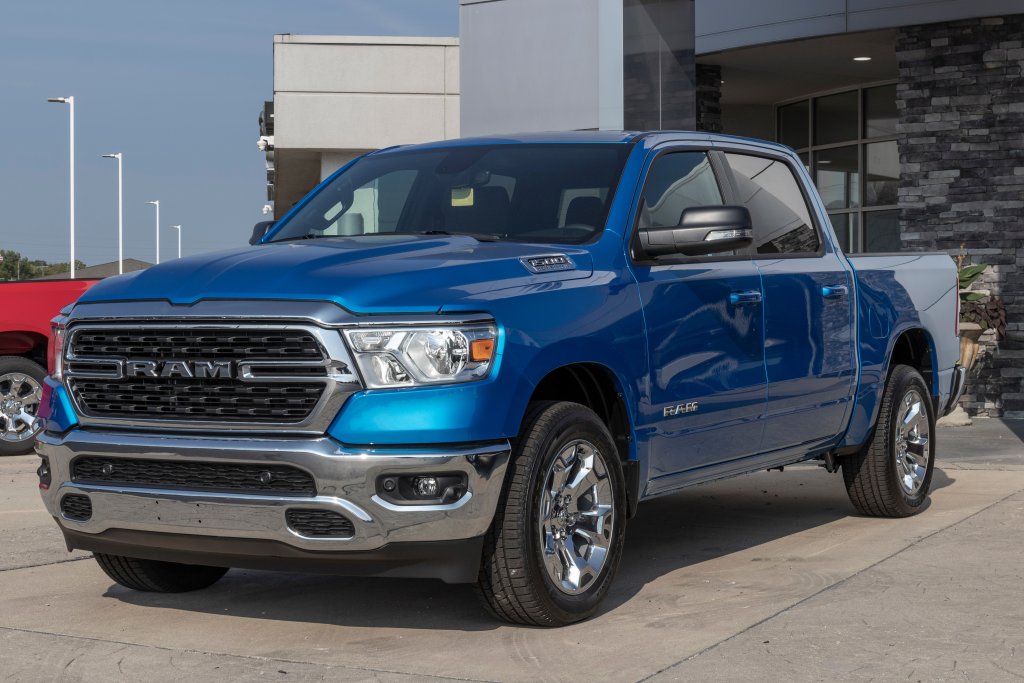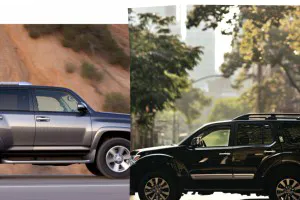The Ram 1500 is a full-size truck that regularly captures America’s hearts. It used to be known as the Dodge Ram 1500, but changed its name in 2011. With nearly 11 million Ram pickups sold since 1996, it’s clear that enthusiasts can’t get enough of this pickup. Yet, there are other pickup trucks ramming their way to the top of the charts, so it’s important to know if this model is worth your money or if you should choose the Ford F-150 or Chevy Silverado instead.
To determine which Ram 1500 models are the best and worst, we analyzed the collected data. The information we’ll go over is essential if you want a used truck to work or play with. And if you currently own a Ram 1500, we will let you know if the truck is worth hanging onto (in our opinion). We gather the data from thousands of FIXD car scanners installed in Ram 1500 models. This information gets paired with the owner surveys and published data for safety ratings, fuel economy, recalls, and KBB value to give you the big picture.
| Best Years | Why? | Worst Years | Why? |
| 2019-2021 |
Exceptional reliability ratings, best fuel economy, low cost of ownership |
2012-2013 |
Below average safety scores, high cost of ownership, increased chance of engine and brake repairs |
| 2014-2018 |
Good reliability scores, favorable fuel economy, reasonable cost for maintenance and repairs |
2001-2005 |
Lower reliability scores, higher likelihood of expensive repairs |
| 2010-2011 |
Decent ownership scores, low chance of engine and transmission repairs |
2009 |
High chance of expensive engine repairs, average reliability scores |
| 2008 |
Recommended by owners, better than average safety rating, low cost of ownership |
2006-2007 |
Low FIXD reliability scores, average cost of ownership |
Ram 1500 Engine Reliability Score, Safety Ratings, MPG and Value v.s. Maintenance & Repair Costs – Year by Year
Before choosing any one of these trucks, you should evaluate the data that we’ve made available. The 4 charts below will quickly help you see the engine reliability, fuel economy, safety scores, repair costs, and resale values for the last 20 model years at a glance.
If you’re in the market for a car, take a look at our article on the USAs’ most reliable and cheapest to repair cars in the U.S. Don’t get stuck with a lemon, use our data to help you shop.
Engine Reliability Score – Over The Years
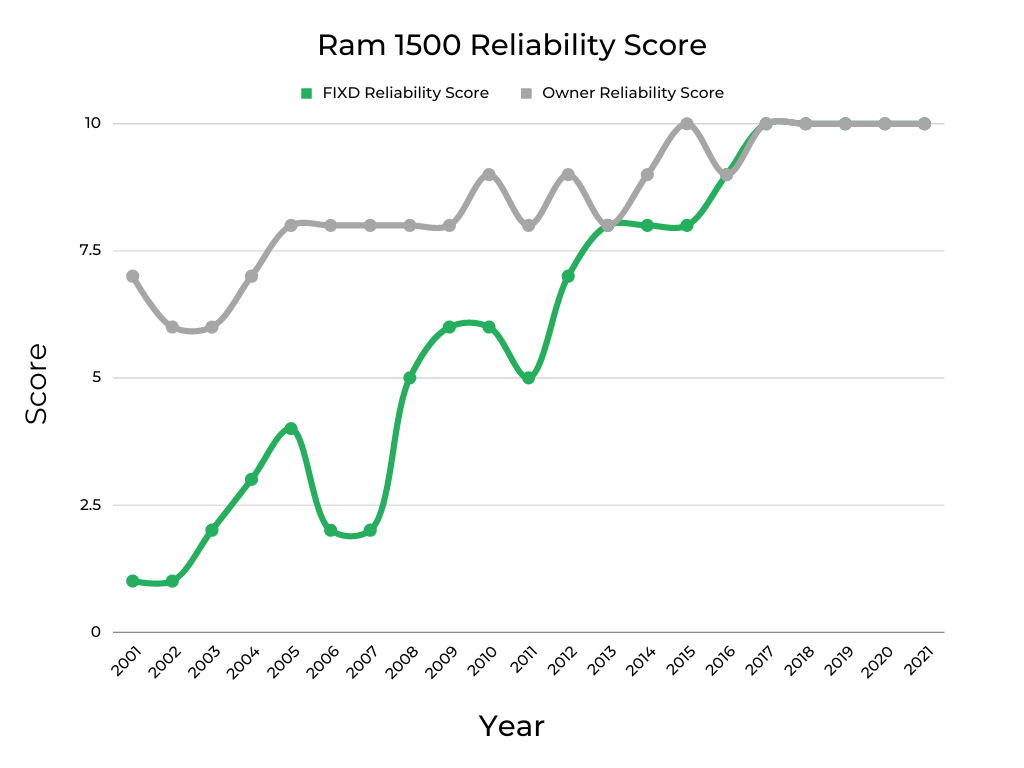
There are 2 varying ratings for you to look over, both giving you the chance to see the reliability of Ram 1500 models.
- The FIXD Reliability score (Green line) – based on how many check engine lights are thrown by Ram trucks every 12,000 miles of driving (1 year’s worth of driving).
- The Owner Reliability score (Gray line) from surveyed RAM 1500 owners.
Overall, the two lines run in a consistent pattern, with owners being much more generous, which isn’t unusual. Also, as the models become newer, the reliability ratings tend to go up (newer models tend to be more reliable).
Take a look at these Ram 1500 reliability scores before you shop for a used truck to decide which years should be skipped. If you have a particular model year already in mind, we recommend jumping ahead to get a detailed report on how it ranks.
NHTSA Safety Score – Over The Years
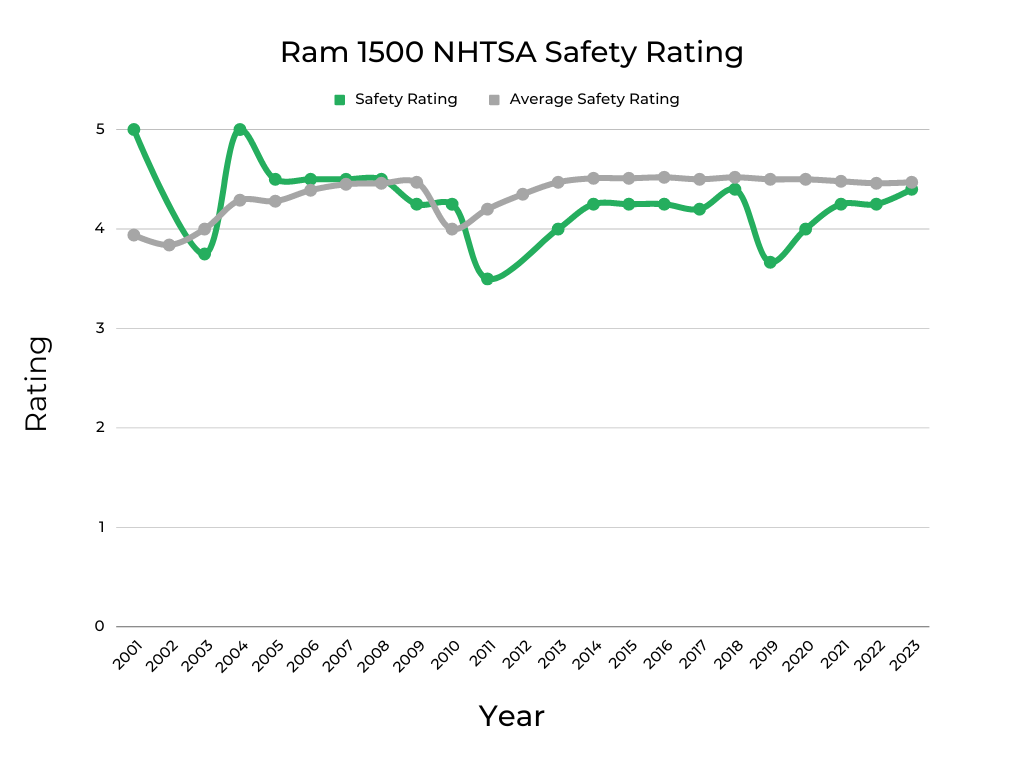
The National Highway Transportation Safety Administration (NHTSA) determines the safety score for every model year. We’ve put this information in a chart for you to see how each truck ranks.
The Average NHTSA Safety Rating for each model year is represented as a Green line. In comparison, the gray line reveals the average ranking of all vehicles we use NHTSA data for. By pairing this information, you can see how well the Ram 1500 ranks among other models.
As you can see, the Ram 1500 dips below averages on multiple occasions. In 2003, 2009, and 2011 onward, the Ram trucks didn’t meet the national average.
The better the safety rating of a truck is, the better your chances are of getting cheap car insurance for your used vehicle.
If you live in one of the states listed below, we can show you the cheapest vehicles to insure in yours.
| What Used Cars Are the Cheapest To Insure In: |
| Ohio |
| North Carolina |
| Michigan |
| Georgia |
| Texas |
| New York |
| Illinois |
| Pennsylvania |
| California |
MPG – Over The Years
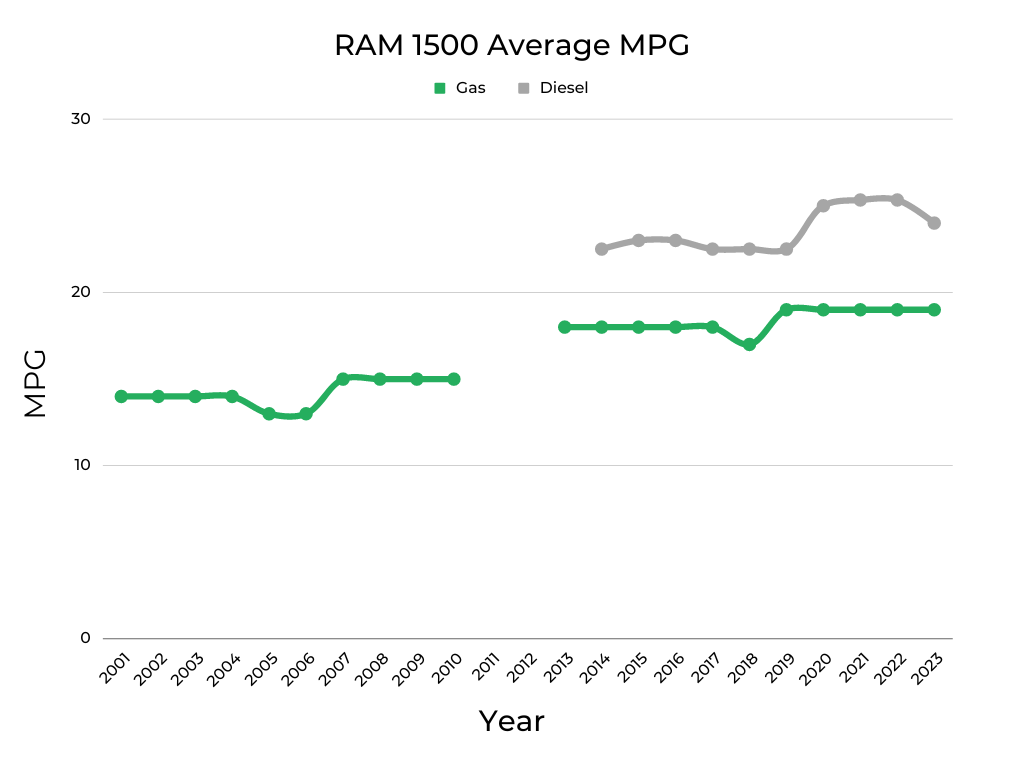
Most truck owners aren’t thinking about fuel economy while picking out the model. It’s not expected that most trucks are going to be fuel-efficient. However, you want to know the rankings so you can save a little bit of money wherever possible. Our graph shows the average mpg by model year based on the data found on fueleconomy.gov.
Looking strictly at the gas-powered models, the most efficient Ram 1500 models are 2019 and newer. If you want a diesel model, you’ll find even better ratings (gray line).
Current Market Value of All Ram 1500 Years & Cost Per Year to Repair and Maintain Each
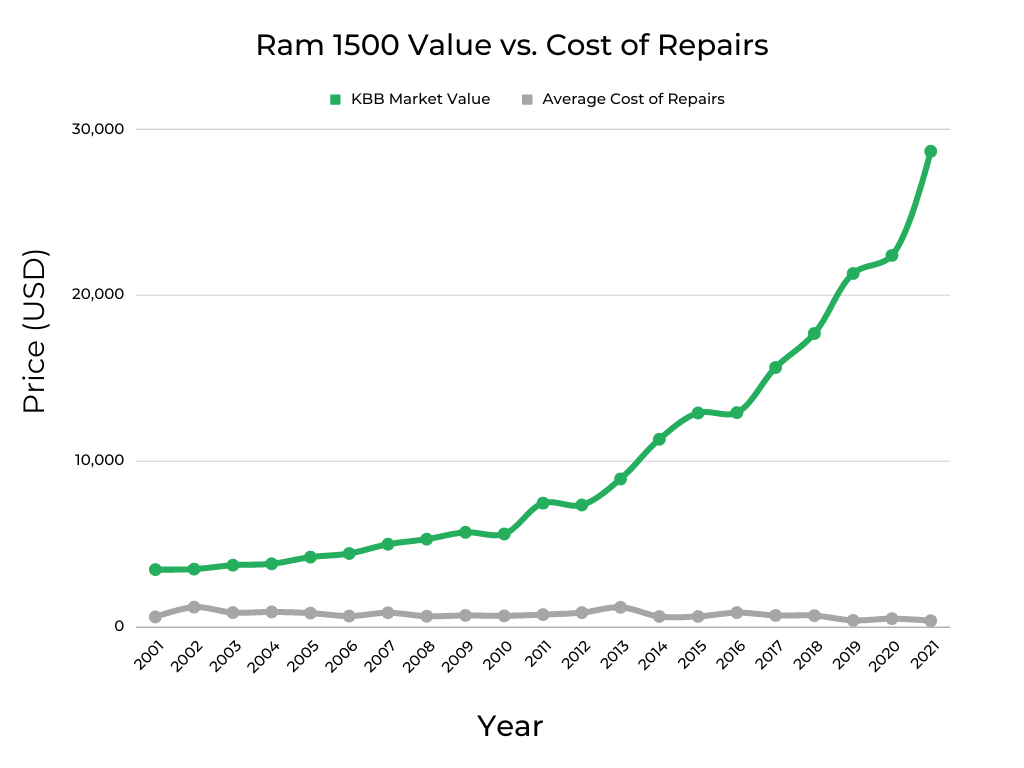
To help budget for upcoming repair and maintenance costs, you can see what others are spending. This number tends to go hand-in-hand with reliability scores, so it’s important to evaluate them as a whole. If the truck is known for engine and transmission repairs, you can expect to pay more. Plus, every time something goes wrong, you have to be without the truck, which could cost you money if you use it for work.
Repair and maintenance costs also affect the resale value of the Ram 1500. If you have a newer truck with fewer problems, the resale value is going to be high. Yet, you can’t just assume that a newer truck is less costly, not all of them are. Sometimes it is quite the opposite and older models turn out to be the ones that require minimum maintenance. You must look at the data.
If you see two trucks with similar resale values, consider buying the newer one. As long as it’s reliable, you can count on better features and a longer life overall.
Our estimated values are determined by each model year with the average mileage reported by our survey respondents. Mileage is going to be one of the most significant factors when looking at used trucks. Therefore, the resale value of the pre-owned truck you look at could be different from what we’ve found because of trim level, equipment, and mileage. Get a resale value report from KBB to ensure you aren’t paying too much.
When shopping for a used Ram 1500, it’s important to keep in mind that not all vehicles are cared for equally. To protect yourself from lemons, take along a FIXD Sensor on your test drive. FIXD connects to a free app on your smartphone to tell you more about the vehicle you’re checking out, including check engine lights and other hidden issues that the owner or dealership may be attempting to hide. Click here to learn more and get FIXD for only $19.99 (regular price $59)!
Important Features Timeline
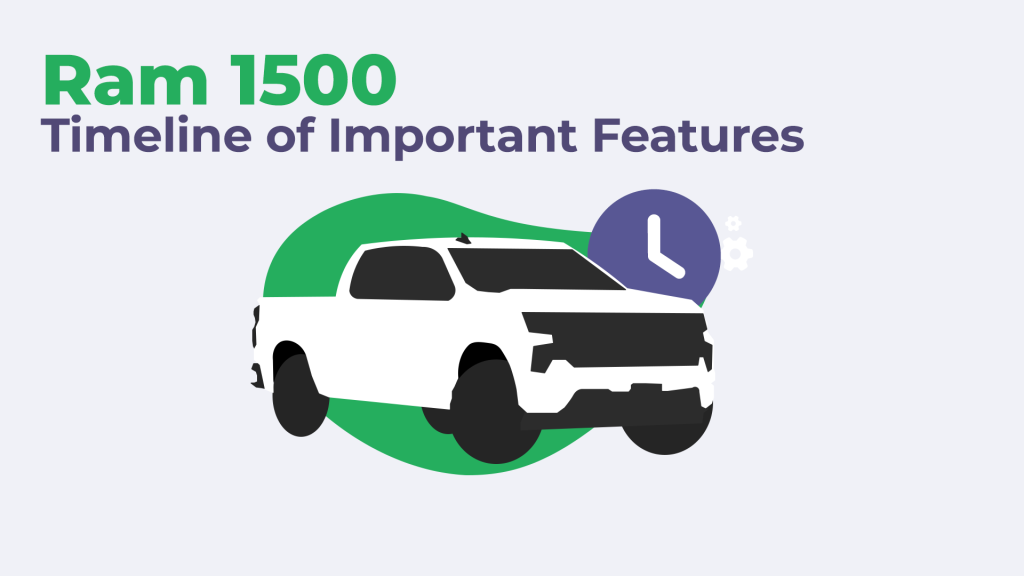
1996: Optional 5.9L turbodiesel V8 earns a torque increase to 440 lb-ft and a governed automatic transmission
1997: SLT models offer available leather seating, Club Cab models now have standard deep-tinted quarter glass and available remote keyless entry
1998: Quad Cab is first in the segment with two rear access doors
1999: Sport model receives new front bumper, grilled, headlights, fascia, and graphics
2000: Club Cab with 8-foot bed discontinued, new off-road package offered for short-wheelbase 4WD trucks
2001: Cummins turbodiesel engines upgraded with electronic cruise control available
2002: Completely redesigned for 3rd generation
2003: Off-Road and Work Special packages debut, Laramie trim replaces the SLT Plus, newly optional five-speed automatic offered with the 3.7L V6 and 4.7L V8
2004: Laramie earns a new grille and interior accents, full-time 4WD released
2005: Crew cab trucks offer optional Sirius Satellite and a power sunroof, 3.7L V6 and 4.7L V8 gain a new six-speed manual transmission
2006: Mega Cab model released with a 20-inch longer cabin, newly optional rear-seat DVD entertainment system and navigation system debut
2007: New stain-resistant seat cloth used in cabs, E85 fuel compatibility added to 4.7L V8
2008: 4WD models earn revised steering linkage, optional stability control receives Trailer Sway Control
2009: Completely redesigned for the 4th generation
2010: Tow rating increases, integrated trailer brake controller and tow mirrors added
2011: Dodge Ram 1500 becomes Ram 1500 with some minor reshuffling of trim levels
2012: New six-speed automatic transmission released
2013: New V6 engine released, eight-speed automatic transmission offered
2014: Optional turbocharged diesel V6 added to the lineup, 4.7L V8 discontinued
2015: R/T released based on the Sport trim
2016: Center console previously in the Laramie, Limited and Rebel trims becomes standard across the lineup, LED cargo box lights available
2017: Outdoorsman trim level discontinued, six-speed automatic transmission removed from the lineup
2018: Tungsten and Harvest Editions available, Rebel offers an optional leather interior, the rearview camera becomes standard with all models
2019: Redesigned for 5th generation with increased payload and towing capacity, reduced weight, more rear-seat room, and a new mild hybrid power system
2020: 3.0L EcoDiesel returns, Night Edition and Black Edition styling packages available
2021: TRX debuts with 702-hp V8, available head-up display introduced, newly optional Trailer Reverse Steering Control unveiled
2022: Backcountry and Limited 10th Anniversary Edition packages available, Uconnect 5 infotainment system released for most trim levels
The Best Years of the Ram 1500
By examining all of the data, we can determine which Ram 1500 models are worth your money. To determine this ranking, we used the FIXD app engine reliability data heavily, but it also had to be balanced with owner feedback scores, fuel economy, and safety ratings. It’s also vital to track the diagnostic trouble codes (DTCs) for each model, as well as look at the open recalls reported by the National Highway Traffic Safety Administration (NHTSA).
2019-2021 Ram 1500
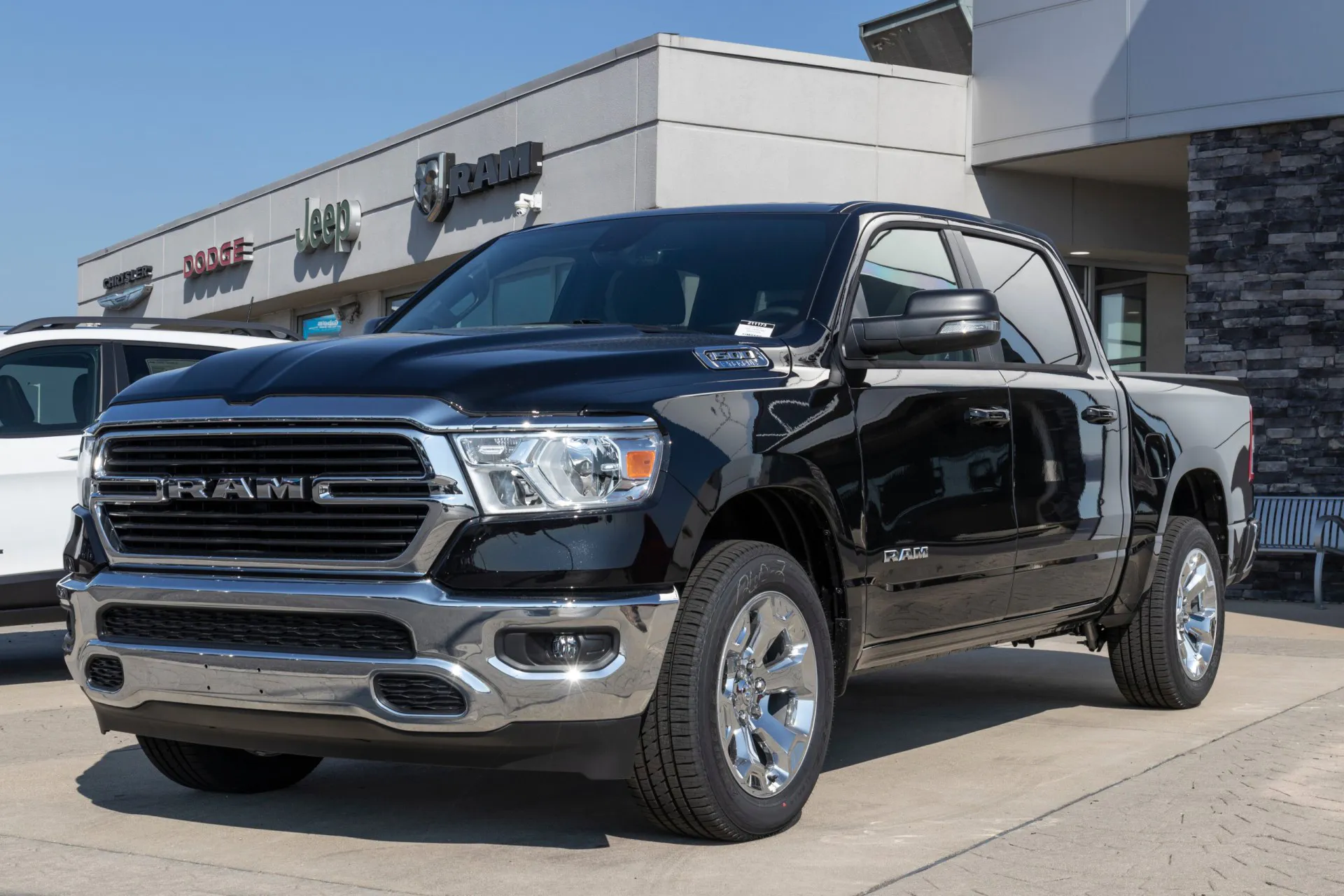
FIXD Reliability Score: 10/10
Owner Reliability Score: 10/10
KBB Value: $21,301-$28,666
Fuel Economy: 19 mpg (gas), 22.5-25 mpg (diesel)
Annual Maintenance/Repair: $365-$488
Safety Rating: 3.67-4.25/5
The 2019 to 2021 Ram 1500 are part of the 5th generation and earn the highest reliability scores. When it comes to maintenance and repairs, the costs are also the lowest.
The FIXD Reliability score for the 2019 to 2021 Ram 1500 is a perfect 10 out of 10. If that’s not enough, the Owners Reliability score also scores these models with a 10 out of 10.
The NHTSA crash testing score for these models is between 3.67 and 4.25 (out of 5). While these aren’t great safety ratings, it’s not uncommon for trucks to score a little lower than other vehicles.
As newer models, the cost of repair and maintenance is naturally going to be among the lowest. For these ranges, the 2021 Ram 1500 shows an average of just $365 per year. Following close behind is the 2019 model at $383 a year, with the 2020 Ram 1500 topping off the bunch at $488 a year. Yet, some of these trucks may still be covered by the 3-year/36,000-mile limited warranty or the 5-year/60,000-mile powertrain warranty, which is also helping to keep the costs down.
The 2019 Ram 1500 shows a higher instance of the Evaporative Emissions System Small Leak Detected (P0456) code. We’ve found that an Evaporative System Integrity Monitor (ESIM) Assembly may resolve the problem, costing between $200 and $560. Additionally, both the 2020 and 2021 Ram 1500 seem to struggle at times with the System Voltage Low (P0562) code. If your truck is still under warranty, these problems can likely be resolved without paying anything out of pocket.
The only major complaint with these trucks is the number of recalls. The 2019 Ram 1500 has 24 open recalls, while the 2020 Ram 1500 is subject to 11. Finally, the 2021 Ram 1500 has ten, so it may be a better option to go with the newer of the three if you can afford to.
2014-2018 Ram 1500
FIXD Reliability Score: 8-10/10
Owner Reliability Score: 9-10/10
KBB Value: $11,308-$17,686
Fuel Economy: 17-18 mpg (gas), 22.5-23 mpg (diesel)
Annual Maintenance/Repair: $620-$851
Safety Rating: 4.2-4.4/5
The 2014 to 2018 Ram 1500 make up the end of the 4th generation. These trucks have good reliability scores and the cost of ownership is still reasonable.
The FIXD Reliability score for the 2014 and 2015 Ram 1500 is an 8 out of 10, while the 2016 model scores a 9 out of 10. Even better, the 2017 and 2018 Ram 1500 earned a perfect 10 out of 10. Additionally, the 2014 and 2016 trucks earned an Owners Reliability score of 9 out of 10, while the 2015, 2017, and 2018 gets a 10 out of 10.
The NHTSA crash testing score is lowest, with the 2017 Ram 1500 at 4.2 (out of 5). The 2014-2016 models earn a little better with a ranking of 4.25 (out of 5), while the 2018 model gets a 4.4 (out of 5).
The 2014 and 2015 Ram 1500 have the lowest cost of ownership from this bunch, averaging $620 a year. The 2018 averages $672, while the 2017 model is rated at $682. Even the 2016, which is the highest of these five models, is still at $851 per year, which isn’t as bad as some that are coming up on our list.
All five Ram 1500 models have a likelihood of the Evaporative Emissions System Small Leak Detected (P0456) code. If a new Evaporative System Integrity Monitor (ESIM) Assembly is needed, it may cost you between $200 and $560. The Evaporative Emission (EVAP) Control System Leak Detected (P0457) code can occur simultaneously.
The 2014 Ram 1500 is the subject of 16 recalls, while the 2015 Ram 1500 has 17. In comparison, the 2016 Ram 1500 has 15, the 2017 Ram 1500 shows 11, and the 2018 Ram 1500 is dealing with 12 open recalls.
2010-2011 Ram 1500
FIXD Reliability Score: 5-6/10
Owner Reliability Score: 8-9/10
KBB Value: $5,596-$7,454
Fuel Economy: 15 mpg
Annual Maintenance/Repair: $658-$733
Safety Rating: 3.5-4.25/5
The last year of the Dodge Ram 1500 was 2010, in 2011 it became the RAM 1500 – a standalone brand. These trucks continue to score well and have a low-ish cost of ownership.
The FIXD Reliability score on the 2010 Dodge Ram 1500 is 6 out of 10, while the 2011 Ram 1500 earns a 5 out of 10. However, the Owners Reliability Scores go up with both, showing 9 out of 10 on the 2010 and 8 out of 10 on the 2011 model.
We aren’t fond of the 2011 NHTSA crash testing score. The 2010 Dodge Ram 1500 scored higher than the 2011 model, at 4.25 (out of 5) versus 3.5 (out of 5).
Yet, both models have a reasonable cost of ownership, with the 2010 Dodge Ram 1500 costing slightly less at $658 per year. Neither model appears to suffer from any major problems, except for a slightly elevated chance of brake repair on the 2010 truck and fuel system issues with the 2011.
Both Ram 1500 models continue to show signs of the Evaporative Emissions System Small Leak Detected (P0456) code. If a new Evaporative System Integrity Monitor (ESIM) Assembly is needed, it may cost you between $200 and $560. Additionally, we show data on these models suffering from the Random, Multiple Misfire Detected (P0300) code, which may require a new camshaft. If that’s the case, you could spend $2,048 to $2,510.
The 2010 Dodge Ram 1500 only suffers from five recalls. In comparison, the 2011 Ram 1500 has four recalls.
2008 Dodge Ram 1500
FIXD Reliability Score: 5/10
Owner Reliability Score: 8/10
KBB Value: $5,280
Fuel Economy: 15 mpg
Annual Maintenance/Repair: $634
Safety Rating: 4.5/5
The 2008 Dodge Ram 1500 is the final pick of our top choices. It has decent reliability scores and continues to be one of the lower-cost options to own.
The FIXD Reliability score on the 2008 Dodge Ram 1500 is 5 out of 10. In comparison, the Owners Reliability Score is rated at 8 out of 10.
The NHTSA crash test rating is better with this model. It earns 4.5 (out of 5), which is pretty good for a full-size truck.
The cost of ownership is also low at $634 a year. For a 2008 model year, it would be expected that this would be higher. However, it does have a slightly elevated risk of expensive brake or AC/heat repairs.
As with the other models, there’s a risk of the Evaporative Emissions System Small Leak Detected (P0456) code. If a new Evaporative System Integrity Monitor (ESIM) Assembly is needed, it may cost you between $200 and $560. On top of that, we do occasionally see the Catalyst System Efficiency Below Threshold (P0420) trouble code. If this repair requires putting on a new catalytic converter, you may spend $1,538 to $2,041.
Sadly, the 2008 Dodge Ram 1500 does have 12 recalls, which seems to be about normal for these trucks.
The Worst Years of the Ram 1500
2012-2013 Ram 1500

FIXD Reliability Score: 7-8/10
Owner Reliability Score: 8-9/10
KBB Value: $7,342-$8,913
Fuel Economy: 18 mpg
Annual Maintenance/Repair: $850-$1,174
Safety Rating: 4/5
While the 2012 and 2013 Ram 1500 trucks may seem to have good ratings, the cost of ownership is some of the highest (more on this in a bit). There are also a lot of systems that tend to need expensive repairs.
The 2012 Ram 1500 earns a FIXD Reliability Score of 7 out of 10, while the 2013 model ranks at 8 out of 10. In comparison, the Owners Reliability Score on the 2012 is 9 out of 10, with the 2013 again getting an 8 out of 10.
The NHTSA crash test rating isn’t terrible on the 2013 Ram 1500. It earns 4.0 (out of 5), which isn’t worth complaining about. At this time, we don’t have the ratings for the 2012 model, but expect they would be similar.
However, the cost of ownership skyrockets with these two models. The 2012 Ram 1500 averages $850 a year and the 2013 truck shows $1,174. Both models have an increased risk of engine and brake repairs. Plus, the 2012 also has elevated instances of expensive transmission repairs, while the 2013 Ram 1500 has more AC/heat and fuel system issues.
There’s still a higher chance of the Evaporative Emissions System Small Leak Detected (P0456) code with both models. If a new Evaporative System Integrity Monitor (ESIM) Assembly is needed, it may cost you between $200 and $560. We also still see the Random, Multiple Misfire Detected (P0300) code, which may require a new camshaft. If that’s the case, you could spend $2,048 to $2,510.
Surprisingly, the 2012 Ram 1500 only has seven recalls, while the 2013 Ram 1500 is subject to 12 recalls.
2001-2005 Dodge Ram 1500
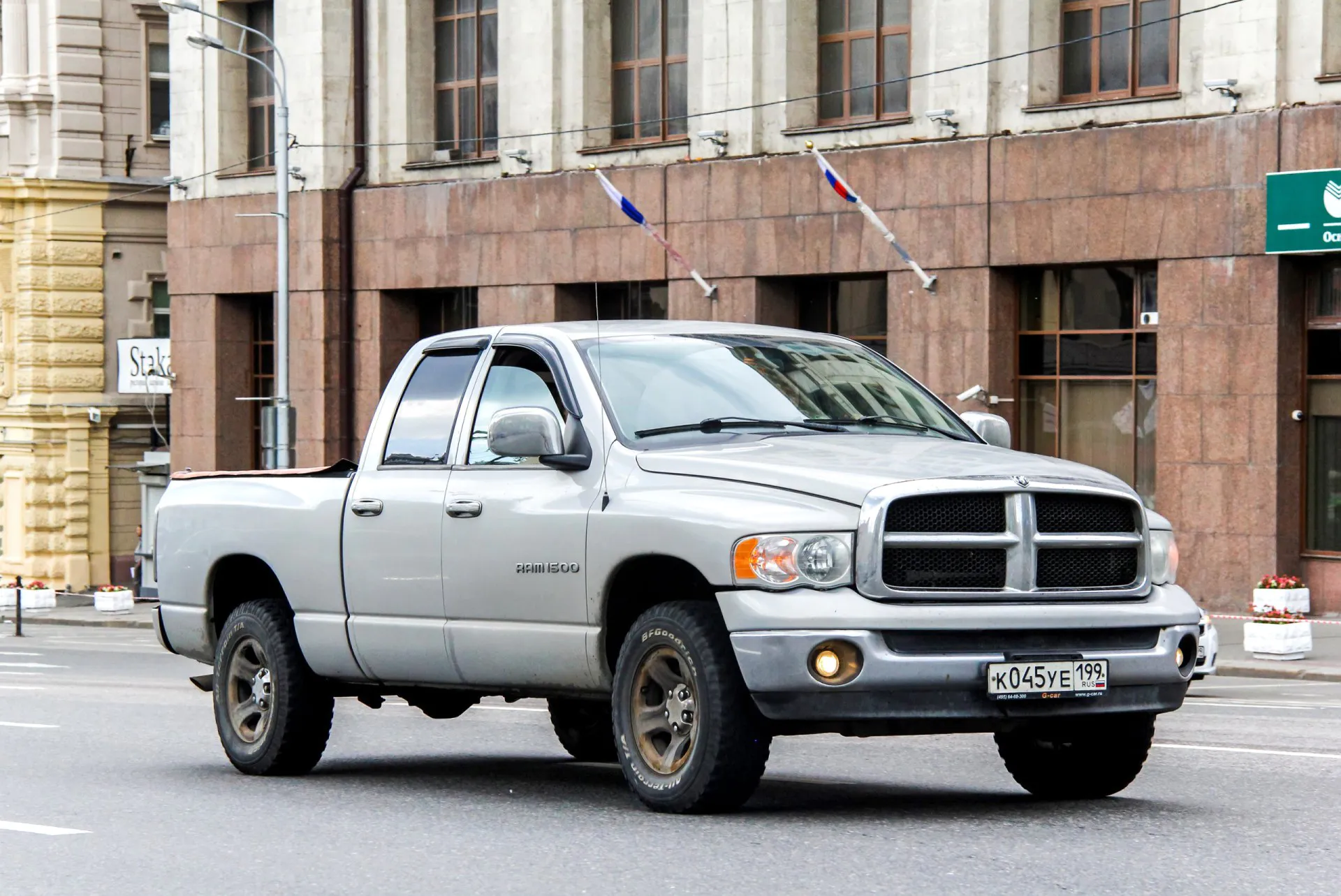
FIXD Reliability Score: 1-4/10
Owner Reliability Score: 6-8/10
KBB Value: $3,447-$4,199
Fuel Economy: 13-14 mpg
Annual Maintenance/Repair: $594-$1,182
Safety Rating: 3.75-5/5
The 2001 to 2005 Dodge Ram 1500 trucks have lower reliability ratings and can cost a lot to own. There’s also an increased chance of expensive repairs.
The 2001 and 2002 Dodge Ram 1500 earns a FIXD Reliability Score of 1 out of 10, and the 2003 Dodge Ram 1500 gets 2 out of 10. Ratings get better with the 2004 model at 3 out of 10 and the 2005 earning 4 out of 10. In comparison, the 2002 and 2003 Dodge Ram 1500 have an Owners Reliability Score of 6 out of 10. Both the 2001 and 2004 trucks have a 7 out of 10 rating, while the 2005 Dodge Ram 1500 gets 8 out of 10.
The NHTSA crash test rating fluctuates, depending on the model. On the low end, the 2003 Dodge Ram 1500 gets 3.75 (out of 5), while the 2001 and 2005 earn a perfect 5.0 (out of 5).
Some of these models have a slightly lower cost of ownership than others. For example, the 2001 Dodge Ram 1500 has a $594 annual average, but the 2002 Dodge Ram 1500 averages $1,182. All five models have a higher chance of engine or transmission repairs, which can become costly. There are also issues across the board with brakes, AC/heat, or fuel system repairs.
The 2003 to 2005 Dodge Ram 1500 still shows the Evaporative Emissions System Small Leak Detected (P0456) code with both models. Yet, the most common repair for these is a Leak Detection Pump (LDP), costing $200 to $560. The 2002 Dodge Ram 1500 suffers from the Random, Multiple Misfire Detected (P0300) code, which may require a new intake manifold gasket. If that’s the case, you could spend $357 to $746. Additionally, the 2001 Dodge Ram 1500 shows the O2 Sensor Circuit High Voltage – Bank 1, Sensor 2 (P0138) code. If your truck needs a new oxygen sensor, you may spend $153 to $306.
The 2001 Dodge Ram 1500 has 16 recalls, while the 2002 Dodge Ram 1500 has 12 recalls. In comparison, the 2003 Dodge Ram 1500 shows 12 recalls, the 2004 Dodge Ram 1500 has 15 recalls, and the 2005 Dodge Ram 1500 is subject to 12 recalls.
2009 Dodge Ram 1500
FIXD Reliability Score: 6/10
Owner Reliability Score: 8/10
KBB Value: $5,695
Fuel Economy: 15 mpg
Annual Maintenance/Repair: $682
Safety Rating: 4.25/5
The 2009 Dodge Ram 1500 doesn’t have terrible reliability ratings or a high cost of ownership. However, there are increased chances of engine, brake, AC/heat, and fuel system repairs.
The 2009 Dodge Ram 1500 earns a FIXD Reliability Score of 6 out of 10. Even better, the 2009 Dodge Ram 1500 has an Owners Reliability Score of 8 out of 10.
The NHTSA crash test rating is 4.25 (out of 5). This rating is above average compared with all other vehicles we track.
The 2009 trucks also have a cost of ownership of around $682 per year. Yet, there are serious concerns about engine, brake, AC/heat, and fuel system repairs.
The 2009 Dodge Ram 1500 suffers from the Random, Multiple Misfire Detected (P0300) code, which may require a camshaft. If that’s the case, you could spend $2,048 to $2,510. The 2009 Dodge Ram 1500 also shows the Evaporative Emissions System Small Leak Detected (P0456) code. With an Evaporative System Integrity Monitor (ESIM) Assembly replacement, you may spend $200 to $560. There’s also the chance of seeing the Catalyst System Efficiency Below Threshold (P0420) trouble code. If this repair requires putting on a new catalytic converter, you may spend $1,538 to $2,041.
The 2009 Dodge Ram 1500 has nine recalls, which seems to be about average compared with other older models.
2006-2007 Dodge Ram 1500
FIXD Reliability Score: 2/10
Owner Reliability Score: 8/10
KBB Value: $4,416-$4,976
Fuel Economy: 13-15 mpg
Annual Maintenance/Repair: $646-$844
Safety Rating: 4.5/5
The 2006 and 2007 Dodge Ram 1500 have a low FIXD rating. It also suffers from a higher chance of expensive repairs to the major systems.
The 2006 and 2007 Dodge Ram 1500 both earn a FIXD Reliability Score of 2 out of 10. However, these two models score much better on the Owners Reliability Score, with a ranking of 8 out of 10.
The NHTSA crash test rating is 4.5 (out of 5) across both models. It’s difficult to score much better than this with a full-size truck.
2006 Dodge Ram 1500 trucks have an average cost of ownership of $646. On the other hand, the 2007 has an average of $844 a year. While the 2006 seems to suffer from more engine trouble, the 2007 truck is known for transmission and AC/heat repairs.
Both trucks are dealing with the Random, Multiple Misfire Detected (P0300) code, which may require an oxygen sensor. If that’s the case, you could spend $153 to $306. The 2007 Dodge Ram 1500 also shows the Evaporative Emissions System Small Leak Detected (P0456) code. There’s a chance it needs an Evaporative System Integrity Monitor (ESIM) Assembly replacement, costing $200 to $560.
The 2006 Dodge Ram 1500 is subject to 16 recalls, while the 2007 Dodge Ram 1500 has 11 recalls issued.
FAQs
What years of the Ram 1500 have engine and/or transmission problems?
The Ram 1500 models with a higher chance of expensive engine repairs include the 2002-2004, 2009, and 2012-2014. There’s also a higher instance of transmission repairs with the 2001-2002, 2005-2006, and the 2012 trucks.
What is considered high mileage for a Ram 1500?
Truck owners aren’t gentle with their vehicles. Drivers are going to tow heavy loads and push the trucks to the extremes. For that reason, it’s difficult to determine how long a Ram 1500 could last when properly cared for. With the right maintenance, the trucks could push 175,000 or more.
Based on our data, a high-mileage Ram 1500 could be considered anything over 125,000 miles.
Older Dodge Ram 1500 models (2001-2010) show an average mileage range between 150,000 and 175,000. Our data shows only a handful of Ram 1500 models exceeding 160,000 miles. Just remember, once the truck has a lot of miles on it, the resale value also drops. There’s no more wiggle room with expensive repair bills once the truck’s value plummets.
At rock bottom, one major mechanical failure could send the truck to the scrapyard. Why? Because repair will probably cost you more than the car is worth. It’s time to cut your losses rather than shoveling money into a sinking ship.
We hope to see the newer lineup of Ram 1500 models lasting longer, but more data is needed to make that determination.
What other vehicles should I consider?
Ram makes an entire lineup of trucks. You could choose a heavy-duty model if you want something more robust. Ram also makes a few different vans known as the Promaster, ideal for anyone needing to carry cargo for deliveries or food service.
If you are willing to move outside of the Ram brand, there are plenty of other truck models to choose from. The Chevy Silverado 1500, Ford F-150, Toyota Tundra, and Nissan Titan are all top contenders. You can also go with a compact truck if you want something smaller, such as the Ford Maverick, Ford Ranger, Chevy Colorado, or Toyota Tacoma.
What owners of the Ram 1500 like to use their car for:
Percent based x/5-star: 0-10% = 1, 11-20% = 2, 21-30% = 3, 31-40% = 4, 41%+ = 5
| Frequent Use Categories: | How Useful? (Out of 5 Stars) |
| Family Vehicle | *** |
| Lots of Driving (travel/long commute) | *** |
| Hauling/Towing | *** |
| Office on Wheels | * |
| Sport/Fast Driving | * |
| Luxurious Driving | * |
| Outdoor/Off-Road | ** |
A Note About Data and Information Sources
This article has many details about Ram 1500 reliability; here’s what we used for our assumptions and recommendations.
- FIXD Reliability Score & Data: Engine reliability information is captured via the FIXD App.
The FIXD Reliability Score is calculated using the number of DTCs per year, weighted by mileage. This is then turned into a scale of 1-10 for easy graphing.
This is an objective score.
- Owner Reliability Score & Data: This data is the result of surveying Ram 1500 owners who use FIXD.
The Owner Reliability Score comes straight from owners of the Ram 1500.
This is a subjective score.
To determine the Owner Reliability Score we ask each car owner:
How reliable would you say your Ram 1500 is?
a. Just point A to point B driving
b. A Daily Commuter
c. Good for a 100 mile road trip
d. Good for a 500 mile road trip
e. I could take a cross-country road trip, no problem
From here we translate their answers into the Owner Reliability Score:
a. = 2
b. = 4
c. = 6
d. = 8
e. = 10
Keep in mind, owners may think their car is more or less reliable than it actually is.
One potential problem is that people often buy the same make or model they are used to when they go car shopping, just a newer year.
Ford, for instance, has a number of consumer loyalty awards for the Ford F-Series, Ford Mustang, and Ford Expedition.
Car owners may be so loyal to the make or model they currently own that they would have trouble accurately comparing their cars’ reliability to others.
It’s for this reason that we ask car owners a question that is relative to mileage rather than relative to other cars.
Still, be mindful of the accuracy of these Owner Reliability Scores, people’s perceptions and unconscious blindspots can skew data.
We suggest looking at both the FIXD Reliability Score and the Owner Reliability Score for this reason.
- KBB Value: Average private-seller valuations as supplied by Kelley Blue Book (KBB), based on a Ram 1500 with typical mileage for that respective model year.
- Fuel Economy: Mileage-per-gallon estimates according to the EPA MPG on Fueleconomy.gov
- Annual Maintenance/Repair: Upkeep expenses as reported by surveyed Ram 1500 owners
- Safety Rating: Crash test data collected and reported by NHTSA. We average all ratings for each year to come up with a simplified, average safety score. This makes it easier to look at on a graph.
References
- Ram Pickup, wikipedia.org. Retrieved May 21, 2023, from https://en.wikipedia.org/wiki/Ram_pickup
- Dodge Ram 1500 review, edmunds.com. Retrieved May 21, 2023, from https://www.edmunds.com/dodge/ram-pickup-1500/
- Ram 1500 review, edmunds.com. Retrieved May 21, 2023, from https://www.edmunds.com/ram/1500/
- Ram Brand Limited Warranty Coverage, ramtrucks.com. Retrieved May 22, 2023, from https://www.ramtrucks.com/warranty.html

Brian Jones owns a used car dealership outside of Dallas, Texas. He has also worked for decades as an ASE Certified Master Technician for a variety of new car dealerships. Now he spends his time consulting dealerships and writing for some renowned publications, such as Motor1 (https://www.motor1.com/info/team/brian-jones/). When he’s not working, he’s tinkering around with pickup trucks and traveling with his family.

